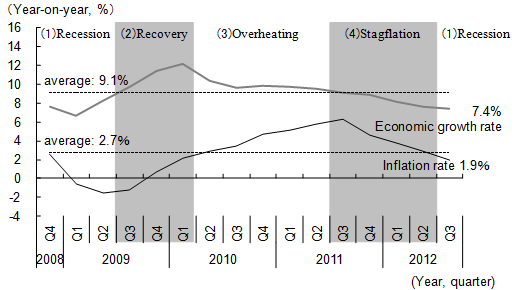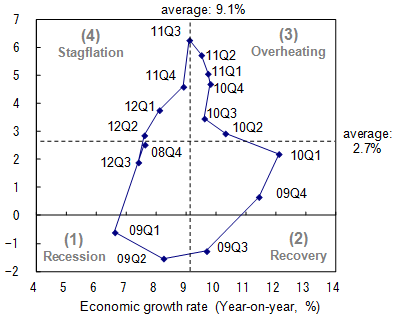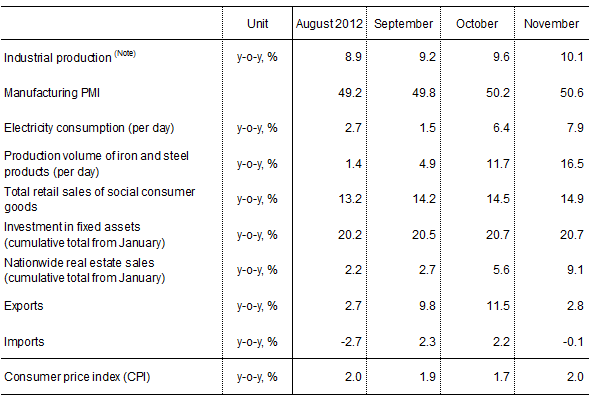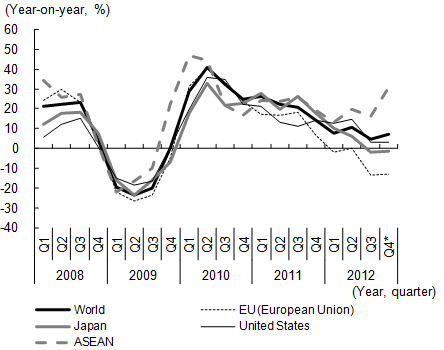The Chinese economy bottomed out in the third quarter of 2012 and has been on a path to moderate recovery since. However, given that the potential growth rate may have fallen significantly, constrained by the labor shortage, it appears that it will be difficult for the country to return to its past growth of 10%, even if the economy recovers.
Cyclical economic fluctuations
The real GDP growth rate in the third quarter of 2012 was 7.4% on a year-on-year basis, the lowest level since the first quarter of 2009 (6.6%), when growth plummeted following the collapse of Lehman Brothers. Responding to the slower growth, the inflation rate has also been falling, from a peak of 6.3% in the third quarter of 2011 to 1.9% in the third quarter of 2012.
In general, the inflation rate is a lagging indicator of the economic growth rate, and it has been confirmed in the case of China that the inflation rate is most highly correlated with the growth rate from three quarters ago. Thus, the economy can be divided into the following four phases, depending on whether the growth and inflation rates are higher or lower than their respective reference values: (1) a recession phase, with low growth and low inflation; (2) a recovery phase, with high growth and low inflation; (3) an overheating phase, with high growth and high inflation; and (4) a stagflation phase, with low growth and high inflation (Figure 1).
— Changes in the economic growth vs. the inflation rate —

phase (3): high growth and high inflation; and phase (4): low growth and high inflation.
If we set the average growth rate (9.1%) and the average inflation rate since the Lehman collapse (2.7%) (the fourth quarter of 2008 through the third quarter of 2012) as the reference values, the Chinese economy has gone through (1) a recession phase (the fourth quarter of 2008 through the second quarter of 2009), (2) a recovery phase (the third quarter of 2009 through the first quarter of 2010), (3) an overheating phase (the second quarter of 2010 through the second quarter of 2011), and (4) a stagflation phase (the third quarter of 2011 through the second quarter of 2012) and returned to (1) a recession phase in the third quarter of 2012.
This business cycle forms a counterclockwise circle in the plane of coordinates with the growth rate as the horizontal axis and the inflation rate as the vertical axis, reflecting the fact that the former moves ahead first while the latter follows with a certain time lag. This circle has just completed a circuit following the Lehman Brothers collapse (Figure 2).

phase (3): high growth and high inflation; and phase (4): low growth and high inflation.
The economy circulates counterclockwise in the order of (1) → (2) → (3) → (4) → (1).
In the wake of the lower growth rate and the easing of inflation, Chinese authorities have been changing their stance on macroeconomic policies since mid-2012, from emphasizing stable prices to focusing on growth. Along with this, the central bank reduced the interest rate twice, in June and July, after lowering reserve requirements three times between December 2011 and May 2012. At the same time, the government accelerated approvals for infrastructure construction and large investment projects.
Thanks to these policies, the economy began turning up from its bottom in August. Year-on-year growth in industrial production (for companies above a certain size on an added-value basis) rose from 8.9% in August to 10.1% in November, and the manufacturing Purchasing Managers' Index (PMI) also improved, from 49.2 to 50.6 (Chart 1). Against this backdrop, the year-on-year growth rate for daily electricity consumption rose from 2.7% to 7.9% in the same period, while the year-on-year growth rate for daily production volume of iron and steel products also recovered, from 1.4% to 16.5%.

By demand component, the year-on-year growth rate for total retail sales of social consumer goods climbed from 13.2% in August to 14.9% in November. Year-on-year growth in investment in fixed assets rose from a cumulative total of 20.2% for the January-August period to a cumulative total of 20.7% for the January-November period. Most importantly, the real estate market, which had entered a correction phase at one point as a result of governmental measures to control demand, is now becoming more robust after monetary easing. Year-on-year growth in real estate sales nationwide rose from a cumulative total of 2.2% for the January-August period to a cumulative total of 9.1% for the January-November period, driven by housing sales. After falling for eight consecutive months from October 2011, prices of newly constructed residential buildings (excluding social security housing for low-income earners) in 70 large and medium-size cities have been picking up since June 2012.
In terms of external demand, growth in exports has finally shown signs of picking up. The year-on-year growth rate, which hit bottom at 4.5% in the third quarter of 2012, recovered to 6.9% in the October-November period (Figure 3). While exports to Japan, the United States, and Europe have remained weak, those to the Association of Southeast Asian Nations (ASEAN) are accelerating, helping to boost growth in overall exports.

Based on these figures, the growth rate is expected to edge up to 8% in the fourth quarter after hitting bottom in the third quarter. Given that the global economy is on the way to a moderate recovery, the growth rate of the Chinese economy is likely to stay above 8% in 2013, building on the current momentum. The inflation rate, a lagging indicator of the growth rate, is unlikely to rise sharply until the second half of this year, leaving room for further monetary easing, which may take the form of lowering reserve requirements, in the first half.
Taking into consideration of the fact that China's potential growth rate may have fallen significantly, constrained by the labor shortage, however, even if the Chinese economy starts to pick up, for the meantime, it is likely to remain in a recession phase of low growth and low inflation, according to the classification discussed above, as the growth rate is unlikely to reach its reference value of 9.1%.
Position on economic policies for 2013
At the Central Economic Work Conference, held December 15-16, 2012, the government determined its stance on the economic policies for 2013.
First, the macroeconomic policy target was changed from "stable and relatively fast growth" in the previous year to "sustainable and sound growth." To that end, the government will maintain a prudent monetary policy and a proactive fiscal policy. Also, in keeping with its policy of "transforming the pattern of economic development," it will aim to increase domestic demand (domestic consumption in particular), rather than external demand. At the same time, with respect to investment, the government will increase public spending on the premise of cutting waste, while promoting private sector investment. Furthermore, the government will not ease its restrictive stance on real estate prices, which has been in place since 2010, and will keep an eye on risks that may result from its fiscal and monetary policies.
In addition to stabilizing the macro economy, the government has established the following as priority issues in its economic policies: strengthening the basis for agriculture, adjusting and improving the industrial structure, promoting urbanization, raising living standards, and promoting structural reform and opening up.
Among them, urbanization was made a priority at the conference this year for the first time. The government hopes that allowing migrant workers from the rural areas to settle in urban areas will stimulate consumption and investment.
With respect to promoting structural reform and opening up, the need for the top echelon to prepare a grand design, including a specific roadmap and timetable, while respecting trial-and-error effort by the private sector, was also emphasized. The complete picture of the new reform proposals will become evident at the third plenary session of the 18th Central Committee of the Communist Party of China to be held in the fall of 2013.
The original text in Japanese was posted on December 27, 2012.


